Aspen Pflughoeft
Mon, May 22, 2023
Walking through the Peruvian Amazon at night, a pair of researchers noticed something tucked among the leaves. The scientists took a closer look at the creature — and discovered a new species.
Study co-authors Germán Chávez and Wilmar Aznaran were surveying a “well-visited” lowland forest in central Peru, Chávez wrote in a May 17 Pensoft blog post. One night, they spotted a small treefrog unlike any they’d ever seen.
“We were quite surprised and kind of speechless,” Chávez said in the blog post. “Externally, the frog is clearly different from any other similar species, and that was evident for us at the very moment we caught it.”
Seen from the top, the roughly 1.5-inch-long treefrog has a dark brown coloring with some speckles of green, according to a study published May 9 in the journal Evolutionary Systems. The animal’s skin looks almost bumpy and textured, photos show.
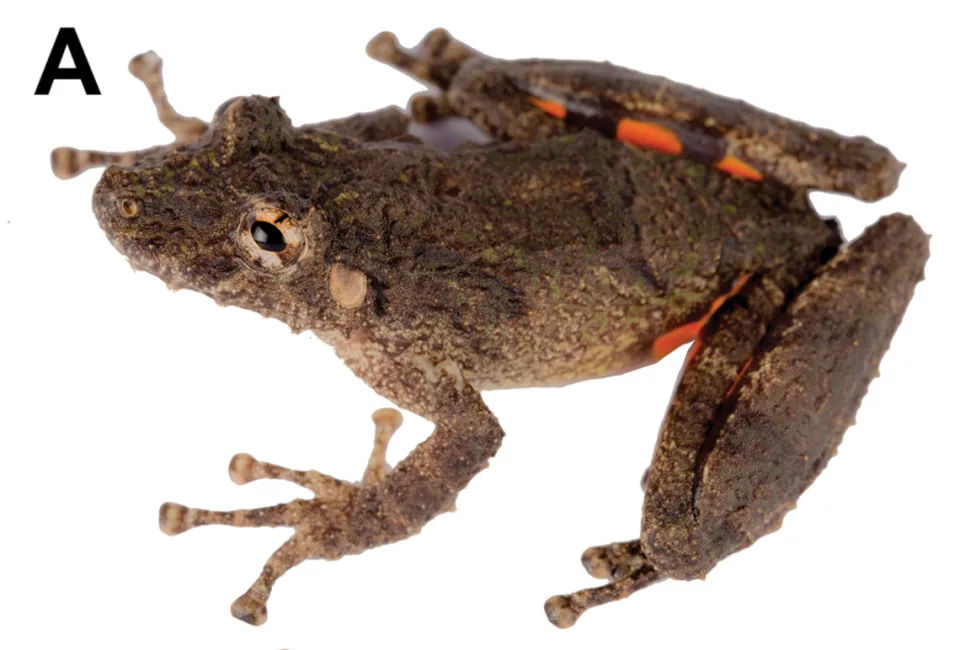
Scinax pyroinguinis as seen from above.
From the underside, the treefrog has “bright orange blotches” along its groins, thighs and legs, researchers said. Photos show the frog’s cream-colored stomach and vibrant, almost fluorescent, orange spots.
Researchers named the new species Scinax pyroinguinis, a Latin name meaning “groins of fire,” after the creature’s “striking” coloring. The name also refers to “the flames of the wildfires threatening its habitat,” the study said.
Scinax pyroinguinis was found only in a small forest patch near the Ucayali River, the study said. The treefrog’s habitat “was surrounded by farms where vegetation has been burnt or converted to pastures.” The remaining forest is still at risk of wildfires.
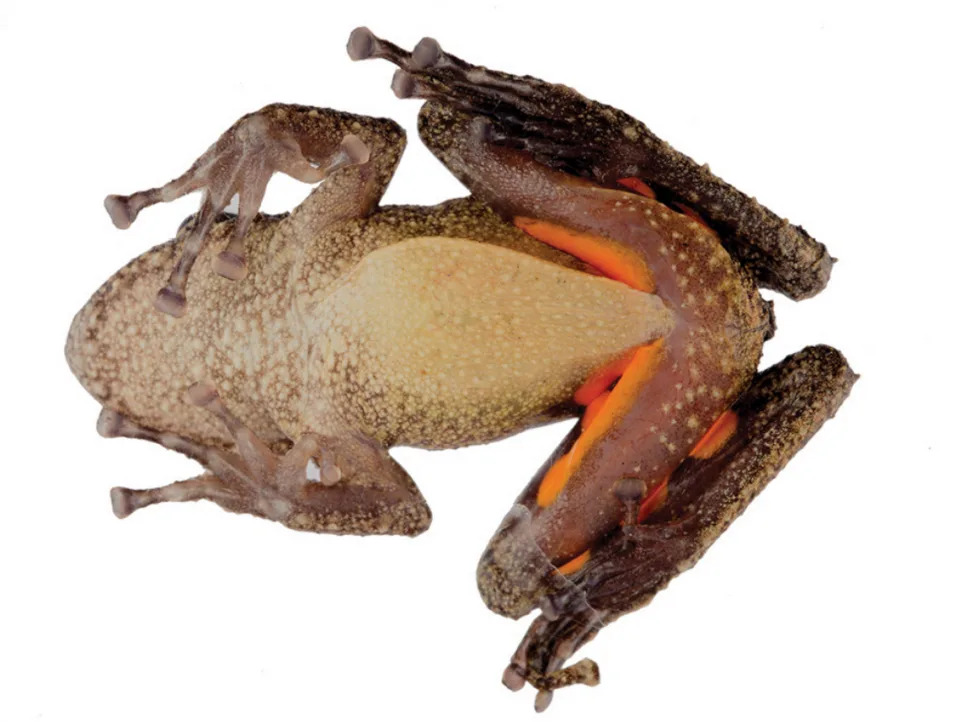
The underside of Scinax pyroinguinis.
“We hope that this discovery encourages people and institutions to protect these remnant forests in central Peru, because they may yet harbour unknown species,” Chávez wrote in the blog post. “ If these forests disappear, we will probably lose a diversity that we do not even know now yet, and may never will.”
The new species is morphologically and genetically distinct from other treefrog species, the study said.
Researchers described Scinax pyroinguinis as an “uncommon” animal. In 108 days searching for the treefrog, researchers found only two specimens, the study said.
Still, researchers “tentatively” identified Scinax pyroinguinis as the “most basal” species of its taxonomic group, the study says. This evolutionary categorization means the newly discovered frog likely gave rise to other species of treefrog.
Chávez told McClatchy News that he hopes to study the new species further in upcoming surveys. “We still need to know more about its reproduction and population status. Our hopes are lying on the next rainy season,” he said.
The Ucayali River is about 330 miles northeast of Lima.
‘Dancing’ creature emerges after rainfall — and discovered as new species in Thailand
Aspen Pflughoeft
Mon, May 22, 2023
A small creature crawled along the rain-dampened ground in a forest in Thailand. The animal’s “dance-like movement” caught the attention of researchers who took a closer look and discovered a new species.
Researchers spotted the animal in a limestone rock area of the Phu Pha Lom Forest, according to a study published May 19 in the journal ZooKeys. They surveyed the area after rainfall and discovered the creature “hiding on the ground and in the leaf litter.”
The animal was identified as a new species of “dancing” semislug: Cryptosemelus niger, researchers said.
Semislugs are slug-like molluscs with snail-like shells that are too small for them to live inside. Dancing semislugs are named for the “dance-like movements that it makes when it is disturbed or attacked,” researchers said.
When the new species was disturbed, “they escaped by quickly flipping and (wagging) their tail,” the study said. Researchers don’t know Cryptosemelus niger’s natural predators but suggested the “dancing” escape mechanisms might be used to avoid carnivorous snails found in the area.

Cryptosemelus niger as seen on a leaf.
Cryptosemelus niger has a “blackish body” with a “dark brown” shell and four antenna-like structures jutting out from its head, researchers said.
Photos show the animal’s coloring and the deep textured grooves on its skin. Among the soil and wood of its habitat, the semislug appears to blend in relatively well.
The new species was named after the Latin word for “black” because of its distinct coloring, the study said.
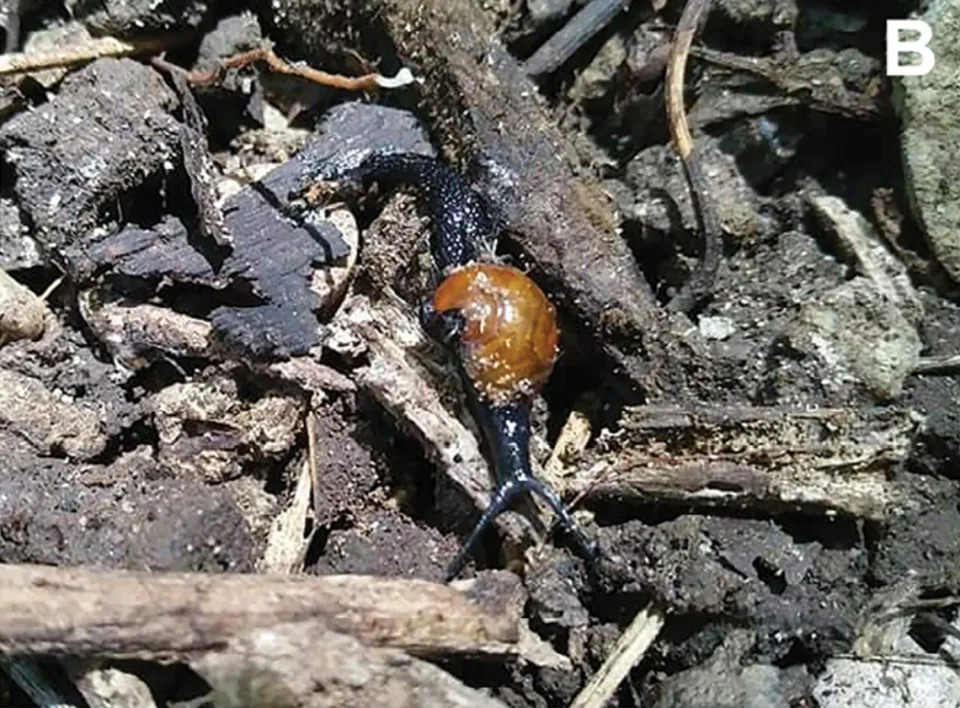
Cryptosemelus niger crawling along ground.
Researchers identified the new species by its morphological characteristics, specifically its tongue-like radula structure, genitalia and body coloring, the study said. They did not analyze the semislug’s DNA or compare its genetic composition to other species.
“Future studies on the (molluscs) of the northeastern part of Thailand require more surveys in overlooked and isolated natural areas,” the study said.
The Phu Pha Lom Forest is about 325 miles northeast of Bangkok and near the Thailand-Laos border.
Aspen Pflughoeft
Mon, May 22, 2023
A small creature crawled along the rain-dampened ground in a forest in Thailand. The animal’s “dance-like movement” caught the attention of researchers who took a closer look and discovered a new species.
Researchers spotted the animal in a limestone rock area of the Phu Pha Lom Forest, according to a study published May 19 in the journal ZooKeys. They surveyed the area after rainfall and discovered the creature “hiding on the ground and in the leaf litter.”
The animal was identified as a new species of “dancing” semislug: Cryptosemelus niger, researchers said.
Semislugs are slug-like molluscs with snail-like shells that are too small for them to live inside. Dancing semislugs are named for the “dance-like movements that it makes when it is disturbed or attacked,” researchers said.
When the new species was disturbed, “they escaped by quickly flipping and (wagging) their tail,” the study said. Researchers don’t know Cryptosemelus niger’s natural predators but suggested the “dancing” escape mechanisms might be used to avoid carnivorous snails found in the area.

Cryptosemelus niger as seen on a leaf.
Cryptosemelus niger has a “blackish body” with a “dark brown” shell and four antenna-like structures jutting out from its head, researchers said.
Photos show the animal’s coloring and the deep textured grooves on its skin. Among the soil and wood of its habitat, the semislug appears to blend in relatively well.
The new species was named after the Latin word for “black” because of its distinct coloring, the study said.

Cryptosemelus niger crawling along ground.
Researchers identified the new species by its morphological characteristics, specifically its tongue-like radula structure, genitalia and body coloring, the study said. They did not analyze the semislug’s DNA or compare its genetic composition to other species.
“Future studies on the (molluscs) of the northeastern part of Thailand require more surveys in overlooked and isolated natural areas,” the study said.
The Phu Pha Lom Forest is about 325 miles northeast of Bangkok and near the Thailand-Laos border.
Hundreds of new species discovered in this remote part of the world, researcher say
JULIA JACOBO
Mon, May 22, 2023
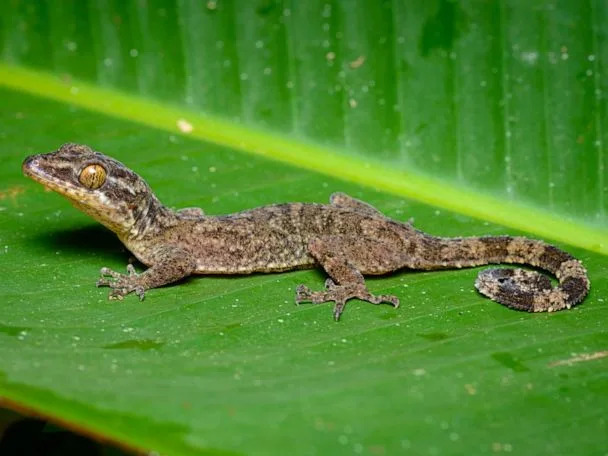
PHOTO: Cyrtodactylus rukhadeva (Thai Nation Parks)
Researchers have discovered hundreds of new animal and plant species in remote parts of the world previously inaccessible to humans, according to the World Wildlife Fund.
Among the 380 newly found species include animal vertebrates such as a color-changing lizard, a thick-thumbed bat, a poisonous snake named after a Chinese mythological goddess, an orchid that looks like a muppet and a tree frog with skin that resembles thick moss. They were all found in the greater Mekong region in Asia, according to the WWF's New Species Discoveries report published on Sunday.
Along the Mekong River, which separates Laos and Thailand, lies miles and miles of forests housed in mountainous regions. Without roads, people have no access to the undiscovered species, which causes them to remain a mystery but also allows them to thrive, K. Yoganand, conservation biologist and wildlife ecologist and WWF-Greater Mekong regional wildlife lead, told ABC News.
"These species have been there," Yoganand said. "It's just, they've escaped, so far, the human destruction."
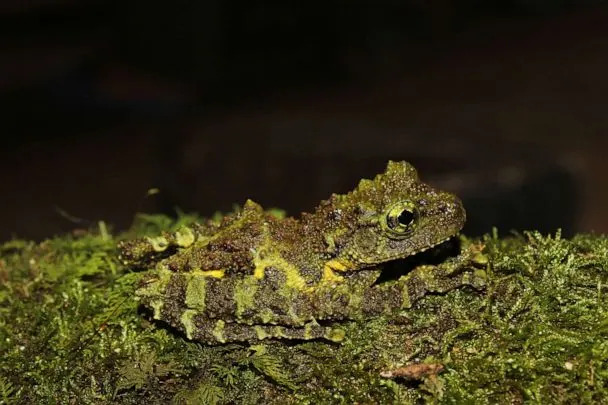
PHOTO: Theloderma khoii. (Le Khac Quyet and Nguyen Thien Tao via WWF)
Hundreds of scientists from universities, conservation organizations and research institutes around the world discovered 290 plants, 19 fishes, 24 amphibians, 46 reptiles and one mammal in Cambodia, Laos, Myanmar, Thailand and Vietnam, according to WWF.
The lush evergreen forests drenched regularly by rainfall and hidden in the mountains may contribute to the plethora of plant and animal species that live there, Yoganand said.
MORE: Asian elephants have lost 64% of their suitable habitat, scientists say
Nearly 4,000 vascular plants, fishes, amphibians, reptiles, birds and mammals have been discovered in the Greater Mekong region since 1997, according to the report.
One of the species scientists learned of is the Khoi's mossy frog, a large, mossy-green colored amphibian, which helps it blend into the lichen and moss-covered stony, leafy background. The discovery was described as a "spectacular find" by the WWF.
An extremely venomous snake called the Suzhen's krait was also found. It was named after the Bai Su Zhen, a snake goddess from a Chinese myth called the Legend of the White Snake, according to the WWF.
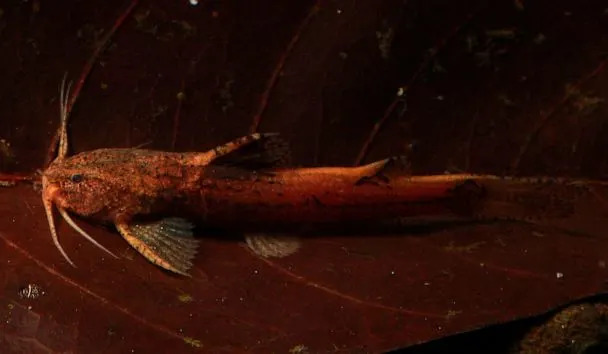
PHOTO: Akysis patrator. (Parinya Pawangkhanant via WWF)
Discovered in the Tenasserim Mountains bordering Myanmar, researchers found Thailand's bent-toed gecko, named after the mythical tree nymph Rukha Deva, who is said to live in trees and protect the forests, according to the WWF. The gecko aggressively opens its mouth and waves its tail side-to-side when threatened, the scientists said.
A semi-aquatic snake now known as Hebius terrakarenorum was found in the Dawna-Tenasserim Landscape between Thailand and Myanmar, according to the report. It is about 2-feet long and was identified entirely from road-kill specimens collected over a decade, as well as a few photos, researchers said.
MORE: Previously extinct bird, gecko populations from the Galapagos Islands have reappeared
Human encroachment is already affecting some of the newly discovered species. In Vietnam, agricultural encroachment and logging, as well as collection by communities to use as a traditional cure for abdominal pain and parasitic infection, is threatening the Thai crocodile newt, researchers said.
In Vientiane, the capital of Laos, the habitat of a new species of gecko is also being fragmented by construction projects, according to the WWF.
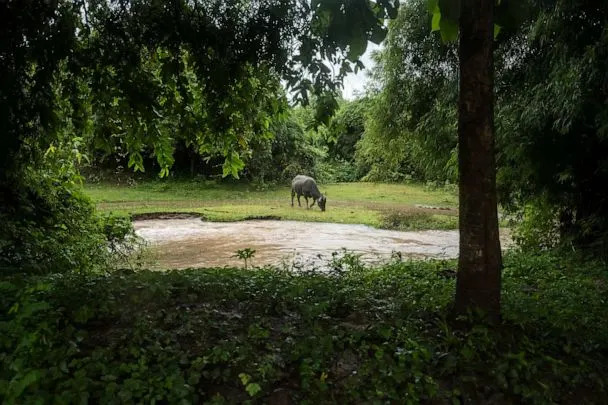
PHOTO: A buffalo is seen grazing on grass by a muddy stream that runs into the Mekong River, Aug. 20, 2022, in Si Phan Don, Laos. (Sirachai Arunrugstichai/Getty Images)
While many of the discoveries were the result of people surveying a never-before-explored area, some of the discoveries were known species that, after further analysis, researchers determined have several different subspecies, Yoganand said.
In Cambodia, researchers discovered the blue-crested agama, an aggressive lizard that changes color as a defensive mechanism. It was identified by studying lizards found near an Angkor era archeological site, according to the WWF. While the species has been known since the first specimen was collected in Myanmar in the 19th century, genetic analysis conducted in 2021 determined that these actually constitute many different species, Yoganand said.
MORE: Climate change, human activity 'decimating' marine life, according to IUCN Red List of Threatened Species
Hayes' thick-thumbed myotis, a mouse-eared bat with unusual fleshy thumbs that was named a new species after a specimen sat in a Hungarian museum for 20 years.
"These remarkable species may be new to science but they have survived and evolved in the Greater Mekong region for millions of years, reminding us humans that they were there a very long time before our species moved into this region," Yoganand said in a statement.
While the Mekong region is a global diversity hotspot it is also experiencing a "vast array of threats," WWF-US Asian Species Manager Nilanga Jayasinghe said in a statement.
"We must continue to invest in the protection and conservation of nature, so these magnificent species don't disappear before we know of their existence," Jayasinghe said.
There are 25 known global diversity hotspots around the world, including the Amazon in Central America and the eastern Himalayas, Yoganand said, adding that he expects the scientific community to keep discovering more and more species.
Immediate action and increased use of new technologies, such as bio-acoustics and genetic sequencing, are needed to help scientists discover more species in the region, Truong Nguyen, a researcher with the Institute of Ecology and Biological Resources at the Vietnam Academy of Science and Technology, said in a statement.
"To reverse the rapid biodiversity loss in the region, more concerted, science based, and urgent efforts need to be made and conservation measures need more attention from governments, NGOs and the public," Nguyen said.
Hundreds of new species discovered in this remote part of the world, researcher say originally appeared on abcnews.go.com
JULIA JACOBO
Mon, May 22, 2023

PHOTO: Cyrtodactylus rukhadeva (Thai Nation Parks)
Researchers have discovered hundreds of new animal and plant species in remote parts of the world previously inaccessible to humans, according to the World Wildlife Fund.
Among the 380 newly found species include animal vertebrates such as a color-changing lizard, a thick-thumbed bat, a poisonous snake named after a Chinese mythological goddess, an orchid that looks like a muppet and a tree frog with skin that resembles thick moss. They were all found in the greater Mekong region in Asia, according to the WWF's New Species Discoveries report published on Sunday.
Along the Mekong River, which separates Laos and Thailand, lies miles and miles of forests housed in mountainous regions. Without roads, people have no access to the undiscovered species, which causes them to remain a mystery but also allows them to thrive, K. Yoganand, conservation biologist and wildlife ecologist and WWF-Greater Mekong regional wildlife lead, told ABC News.
"These species have been there," Yoganand said. "It's just, they've escaped, so far, the human destruction."

PHOTO: Theloderma khoii. (Le Khac Quyet and Nguyen Thien Tao via WWF)
Hundreds of scientists from universities, conservation organizations and research institutes around the world discovered 290 plants, 19 fishes, 24 amphibians, 46 reptiles and one mammal in Cambodia, Laos, Myanmar, Thailand and Vietnam, according to WWF.
The lush evergreen forests drenched regularly by rainfall and hidden in the mountains may contribute to the plethora of plant and animal species that live there, Yoganand said.
MORE: Asian elephants have lost 64% of their suitable habitat, scientists say
Nearly 4,000 vascular plants, fishes, amphibians, reptiles, birds and mammals have been discovered in the Greater Mekong region since 1997, according to the report.
One of the species scientists learned of is the Khoi's mossy frog, a large, mossy-green colored amphibian, which helps it blend into the lichen and moss-covered stony, leafy background. The discovery was described as a "spectacular find" by the WWF.
An extremely venomous snake called the Suzhen's krait was also found. It was named after the Bai Su Zhen, a snake goddess from a Chinese myth called the Legend of the White Snake, according to the WWF.

PHOTO: Akysis patrator. (Parinya Pawangkhanant via WWF)
Discovered in the Tenasserim Mountains bordering Myanmar, researchers found Thailand's bent-toed gecko, named after the mythical tree nymph Rukha Deva, who is said to live in trees and protect the forests, according to the WWF. The gecko aggressively opens its mouth and waves its tail side-to-side when threatened, the scientists said.
A semi-aquatic snake now known as Hebius terrakarenorum was found in the Dawna-Tenasserim Landscape between Thailand and Myanmar, according to the report. It is about 2-feet long and was identified entirely from road-kill specimens collected over a decade, as well as a few photos, researchers said.
MORE: Previously extinct bird, gecko populations from the Galapagos Islands have reappeared
Human encroachment is already affecting some of the newly discovered species. In Vietnam, agricultural encroachment and logging, as well as collection by communities to use as a traditional cure for abdominal pain and parasitic infection, is threatening the Thai crocodile newt, researchers said.
In Vientiane, the capital of Laos, the habitat of a new species of gecko is also being fragmented by construction projects, according to the WWF.

PHOTO: A buffalo is seen grazing on grass by a muddy stream that runs into the Mekong River, Aug. 20, 2022, in Si Phan Don, Laos. (Sirachai Arunrugstichai/Getty Images)
While many of the discoveries were the result of people surveying a never-before-explored area, some of the discoveries were known species that, after further analysis, researchers determined have several different subspecies, Yoganand said.
In Cambodia, researchers discovered the blue-crested agama, an aggressive lizard that changes color as a defensive mechanism. It was identified by studying lizards found near an Angkor era archeological site, according to the WWF. While the species has been known since the first specimen was collected in Myanmar in the 19th century, genetic analysis conducted in 2021 determined that these actually constitute many different species, Yoganand said.
MORE: Climate change, human activity 'decimating' marine life, according to IUCN Red List of Threatened Species
Hayes' thick-thumbed myotis, a mouse-eared bat with unusual fleshy thumbs that was named a new species after a specimen sat in a Hungarian museum for 20 years.
"These remarkable species may be new to science but they have survived and evolved in the Greater Mekong region for millions of years, reminding us humans that they were there a very long time before our species moved into this region," Yoganand said in a statement.
While the Mekong region is a global diversity hotspot it is also experiencing a "vast array of threats," WWF-US Asian Species Manager Nilanga Jayasinghe said in a statement.
"We must continue to invest in the protection and conservation of nature, so these magnificent species don't disappear before we know of their existence," Jayasinghe said.
There are 25 known global diversity hotspots around the world, including the Amazon in Central America and the eastern Himalayas, Yoganand said, adding that he expects the scientific community to keep discovering more and more species.
Immediate action and increased use of new technologies, such as bio-acoustics and genetic sequencing, are needed to help scientists discover more species in the region, Truong Nguyen, a researcher with the Institute of Ecology and Biological Resources at the Vietnam Academy of Science and Technology, said in a statement.
"To reverse the rapid biodiversity loss in the region, more concerted, science based, and urgent efforts need to be made and conservation measures need more attention from governments, NGOs and the public," Nguyen said.
Hundreds of new species discovered in this remote part of the world, researcher say originally appeared on abcnews.go.com
Huge prehistoric-looking creature spotted in California lake. Take a look — if you dare
Don Sweeney
Mon, May 22, 2023
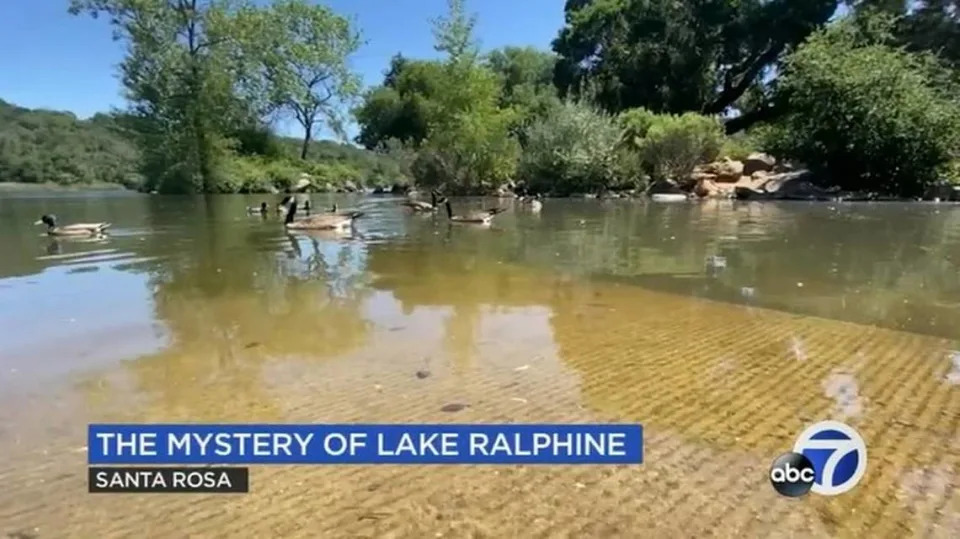
Screengrab from KGO video
At first, Carlos Rubio couldn’t figure out what he saw beneath the water of Lake Ralphine in a California park.
“At first I thought it was a boulder moving in the water,” Rubio told KGO.
Video posted to Reddit by Rubio shows a large, rock-like object moving under the water in the Howarth Park lake in Santa Rosa.
“I realized it was a pretty big snapping turtle,” Rubio told KGO. He said the turtle appeared to be about the size of a spare tire.
Don Sweeney
Mon, May 22, 2023

Screengrab from KGO video
At first, Carlos Rubio couldn’t figure out what he saw beneath the water of Lake Ralphine in a California park.
“At first I thought it was a boulder moving in the water,” Rubio told KGO.
Video posted to Reddit by Rubio shows a large, rock-like object moving under the water in the Howarth Park lake in Santa Rosa.
“I realized it was a pretty big snapping turtle,” Rubio told KGO. He said the turtle appeared to be about the size of a spare tire.
Snapping turtle at Howarth Park
by u/CRSR707 in santarosa
Snapping turtles are not native to California and are illegal to own without a permit, wildlife experts told The Press Democrat.
“Unfortunately, a lot of people get them when they’re babies and do not care about the law,” Wendy Rozonewski of JNW Animal Rescue in Vallejo told the publication. “But when they start to get too big or aggressive, they start releasing the animals in water or not far from where they live. It will survive. The problem is, it kills off our native species.”
The turtle in Lake Ralphine could be one of three subspecies, SFGate reported.
One, the “dinosaur-like” alligator snapping turtle, can reach up to 175 pounds, the National Wildlife Federation said.
“They’ll eat anything — I mean anything. If you put your foot in front of it, it will bite you,” Rozonewski told KGO.
Greg Martinelli, a program manager with the California Department of Fish and Wildlife’s Bay Delta Region, told The Press Democrat the turtles are “voracious and omnivorous.” They’ve been known to bite the legs off birds floating in the water.
The agency and Santa Rosa parks officials are investigating.
Santa Rosa is a city of 177,000 people about 55 miles north of San Francisco.
by u/CRSR707 in santarosa
Snapping turtles are not native to California and are illegal to own without a permit, wildlife experts told The Press Democrat.
“Unfortunately, a lot of people get them when they’re babies and do not care about the law,” Wendy Rozonewski of JNW Animal Rescue in Vallejo told the publication. “But when they start to get too big or aggressive, they start releasing the animals in water or not far from where they live. It will survive. The problem is, it kills off our native species.”
The turtle in Lake Ralphine could be one of three subspecies, SFGate reported.
One, the “dinosaur-like” alligator snapping turtle, can reach up to 175 pounds, the National Wildlife Federation said.
“They’ll eat anything — I mean anything. If you put your foot in front of it, it will bite you,” Rozonewski told KGO.
Greg Martinelli, a program manager with the California Department of Fish and Wildlife’s Bay Delta Region, told The Press Democrat the turtles are “voracious and omnivorous.” They’ve been known to bite the legs off birds floating in the water.
The agency and Santa Rosa parks officials are investigating.
Santa Rosa is a city of 177,000 people about 55 miles north of San Francisco.

No comments:
Post a Comment